What's New
Displaying results 2451 - 2460 of 4914
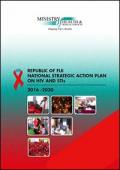
Resource | Publications,
Twenty seven [27] years have elapsed since the first HIV case was reported in Fiji in 1989. Since then, in recognising HIV and AIDS as a development issue, the Government, through the collaboration of stakeholders and the coordination of the Ministry of Health and Medical Services, has sustained a national response, in conformity with the changing profile of the epidemic. As with the previous National Strategic Plan (NSP) for STIs, HIV & AIDS, this strategic plan has been updated and expanded to ensure that the response reaches beyond the health sector. Due to the diverse range of factors that have influenced the epidemic, multi-sectoral partners including other government partners, civil society organisations, faith-based organisations and the key affected populations have been actively involved, not only in the planning and the development of the national response, but also in the implementation of the national plan. Fiji’s coordinated multi-sectoral response is showing positive achievements.
The National Strategic Action Plan (NSP) 2016-2020 on STIs, HIV and AIDS is linked to the Sustainable Development Goals (SDG), the ambitious treatment strategy [90-90-90] and the Fiji Ministry of Health and Medical Services Strategic Plan 2016-2020. This NSP will continue to place strong emphasis on strengthening the multi-sectoral collaboration as undertaken in the previous NSPs.

Resource | Publications,
The ‘Start Free, Stay Free, AIDS Free’ Super-Fast- Track framework and action plan builds on remarkable success achieved between 2011 and 2015 in reducing the number of new HIV infections among children as well as increasing the number of children with HIV on treatment.
It provides a menu of policy and programmatic actions designed to enable countries and partners to close the remaining HIV prevention and treatment gap for children, adolescents young women, and expectant mothers.
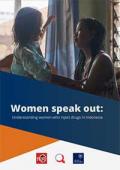
Resource | Publications,
Indonesia is home to about 74,000 people who inject drugs, of whom 11% are women. Compared with men who inject drugs, women who inject drugs experience an elevated risk of HIV and other blood borne virus transmission, disproportionately high rates of violence from both intimate and non-intimate partners, and social exclusion. Despite their specific needs and greater marginalisation, this group has been largely neglected in Indonesia’s national HIV strategy.
The study explored sexual and injecting behaviours, health indicators, gender-based violence, contact with law enforcement, and uptake of health and support services among women who inject drugs. The broad objective of the study was to better understand the experiences of women who inject drugs and to inform evidence-based responses that can mitigate the impacts of drug use and HIV and AIDS on this vulnerable population in Indonesia.

Resource | Publications,
This paper describes methodological details used by WHO in 2016 to estimate TB incidence, prevalence and mortality. Incidence and mortality are disaggregated by HIV status, age and sex. Methods to derive MDR-TB burden indicators are detailed. Four main methods were used to derive incidence: (i) case notification data combined with expert opinion about case detection gaps (74 countries representing 22% of global incidence in 2015); (ii) results from TB prevalence surveys (20 countries, 62% of global incidence); (iii) notifications in high-income countries adjusted by a standard factor to account for under-reporting and underdiagnosis (118 countries, 15.5% of global incidence) and (iv) capture-recapture modelling (5 countries, 0.5% of global incidence). Mortality was obtained from national vital registration systems of mortality surveys in 128 countries (52% of global HIV-negative TB mortality). In other countries, mortality was derived indirectly from incidence and case fatality ratio.
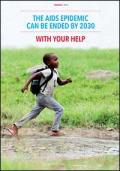
Resource | Publications,
UNAIDS’ Fast-Track response for ending the AIDS epidemic recognizes that with today’s science and tools we can enable full HIV prevention, diagnosis and treatment. But AIDS can only be ended as a public health threat by 2030 if we collectively continue to strive for equality, protection of human rights and zero discrimination.
Between 2016 and 2020, we have a narrow window of opportunity to fill the AIDS resource gap and accelerate access to comprehensive HIV services. These services aim to prevent people from acquiring HIV, to reduce the number of people dying from AIDS-related causes and to eliminate stigma and discrimination through a human rights-based approach. With your support, UNAIDS and our partners will be able to Fast-Track the global response. Together we can end the AIDS epidemic by 2030.
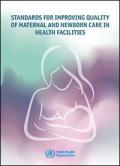
Resource | Publications,
Much progress has been made during the past two decades in coverage of births in health facilities; however, reductions in maternal and neonatal mortality remain slow. With increasing numbers of births in health facilities, attention has shifted to the quality of care, as poor quality of care contributes to morbidity and mortality. The period around childbirth is the most critical for saving the maximum number of maternal and newborn lives and preventing stillbirths. WHO sees a future in which “Every pregnant woman and newborn receives high-quality care throughout pregnancy, childbirth and the postnatal period”. To realize this vision, WHO has defined “quality of care” and has prepared a framework for improving the quality of care for mothers and newborns around the time of childbirth.
The framework contains eight domains of quality of care that should be assessed, improved and monitored within the health system. The health system provides the structure for access to high-quality care in the two important, inter-linked dimensions of provision and experience of care.
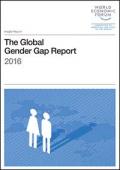
Resource | Publications,
The Global Gender Gap Index was first introduced by the World Economic Forum in 2006 as a framework for capturing the magnitude of gender-based disparities and tracking their progress over time. The Index benchmarks national gender gaps on economic, education, health and political criteria, and provides country rankings that allow for effective comparisons across regions and income groups. The rankings are designed to create global awareness of the challenges posed by gender gaps and the opportunities created by reducing them. The methodology and quantitative analysis behind the rankings are intended to serve as a basis for designing effective measures for reducing gender gaps.
This year’s 11th edition continues to build on the well-established strengths of the Report while adapting a number of elements—namely, the Index’s threshold for calculating gender gaps in estimated earned income, the Report’s regional classification, and visualization of results—to evolve the Global Gender Gap Index for its second decade.
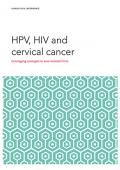
Resource | Publications,
This report presents recent scientific evidence about the links between HIV, HPV and cervical cancer, and it supplies relevant epidemiological, screening, vaccination and innovation data. Ultimately, its goal is to (a) promote synergies between HIV and cervical cancer prevention programmes, (b) make the case for integrating cervical cancer prevention into existing HIV treatment and prevention programmes, (c) explain the opportunities for women’s health that exist in coordinating HIV and cervical cancer prevention, and (d) advance prevention and treatment literacy among affected populations.

Resource | Publications,
Given the developments in the Asia-Pacific region and beyond since the global Expert Group Meeting on VAWG prevention that took place in 2012, UN Women and UNFPA, in partnership with the Australian Government and KWDI, hosted an Asia-Pacific Forum on Preventing Violence against Women and Girls: Evidence and Tools for Social Norm Change, for senior experts, policymakers, practitioners and development partners on 1-2 December 2015 in Bangkok, Thailand. The primary aim was to reflect on how social norms change can be affected, share concrete evidence and good practices in the area of prevention, present practical and evaluated tools to promote and implement preventive actions, and explore ways forward.
This learning paper provides an overview of the evidence coming out of the Forum on Preventing Violence against Women and Girls.
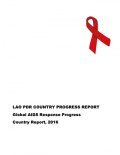
Resource | Publications,
The 2016 Global AIDS Response Progress Reporting was conducted through an inclusive consultative process among the HIV stakeholders and partners. Inputs and contributions came from a wide range of stakeholders in Lao PDR including government agencies, CSOs, network of people living with HIV (PLHIV), mass organizations, international and local nongovernmental organizations (INGO), UN, bilateral and multilateral agencies. The report was developed and consolidated under the leadership of the MOH – CHAS, on behalf of the NCCA. The UNAIDS Country Office and the Regional Support Team‐Asia Pacific provided technical guidance and supported an international consultant who worked closely with the national team of experts in developing the Lao PDR GARPR 2016.





